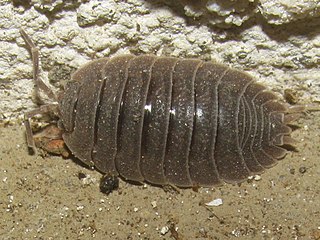
Isopoda is an order of crustaceans. Members of this group are called isopods and include both aquatic species, and terrestrial species such as woodlice. All have rigid, segmented exoskeletons, two pairs of antennae, seven pairs of jointed limbs on the thorax, and five pairs of branching appendages on the abdomen that are used in respiration. Females brood their young in a pouch under their thorax called the marsupium.
Curassanthura is a genus of isopod crustaceans in the family Leptanthuridae. It contains the following species:

Serolis is a genus of isopod crustacean, containing the following species:

Idotea is a genus of isopod crustaceans, mostly from cold temperate waters. The taxonomy of the genus is still in doubt, and many of the currently recognised species may be taxonomic synonyms, and others may be moved to different genera.

Idoteidae is a family of aquatic isopods.

Cymothoida is a suborder of isopod crustaceans with a mostly carnivorous or parasitic lifestyle. It contains more than 2,700 described species in four superfamilies. Members of the suborder are characterised by their specialised mouthparts which include a mandible with a tooth-like process which is adapted for cutting or slicing.

Sphaeromatidea is a suborder of isopod crustaceans.

Serolidae is a family of isopod crustaceans. The family encompasses 22 genera with 109 species. These species are exclusively marine and are distributed across the marine realms as follows: one species can be found in the Temperate Northern Atlantic, one species in the Temperate Northern Pacific, seven species in the Tropical Atlantic, six species in the Central Indo-Pacific, 16 species in Temperate South America, one species in Temperate Southern Africa, 20 species in Temperate Australasia, and 31 species in the Southern Ocean.

Platyarthridae is a family of woodlice, containing the following genera:

The Aegidae are a family of isopod crustaceans. The adults are temporary parasites of fish, feeding on their hosts' blood before dropping off to digest the meal. They differ from members of the family Cirolanidae in having only three pairs of hook-like pereiopods, whereas in Cirolanidae all seven pairs of pereiopods are hooked. The family was first described by Adam White in 1850.

Ligia baudiniana is a woodlouse in the family Ligiidae. It has a coarsely granular surface and large eyes that are very close together.

Ligia dilatata is a woodlouse in the family Ligiidae.

Porcellio dilatatus is a species of woodlouse in the genus Porcellio belonging to the family Porcellionidae. This species is widespread in Europe, and has also been introduced to North America from Western Europe. They are 15 millimetres (0.59 in) long, are brown coloured and striped. They can be found feeding on alder leaves, but mostly feeds on organic food substrates, such as lettuce in the wild. It also feeds on inorganic metal salts.

Trachelipus ratzeburgii is a species of woodlouse in the genus Trachelipus belonging to the family Trachelipodidae that can be found in Austria, the Baltic states, Belgium, the Netherlands, Slovenia, Croatia, the Czech Republic, France, Germany, Hungary, Italy, Poland, Romania, Slovakia, Switzerland and Scandinavia. The species has three subspecies:
Porcellionides cilicius is a woodlouse that can be found on Cyprus and in Turkey. The species have one subspecies Porcellionides cilicius antiochensis that can be found only on Cyprus.

Glyptidotea is a monotypic genus of isopod in the family Idoteidae. Its sole member is Glyptidotea lichtensteini, the keeled isopod, a medium-sized isopod found on the coast of southern Africa.

Pentidotea is a genus of isopods in the family Idoteidae. There are about 13 described species in Pentidotea.

Euidotea durvillei, known commonly as the red seaweed isopod, is a species of marine isopod found in New Zealand.

Brucerolis brandtae is a species of marine isopod in the family Serolidae, found in the Southern Ocean in the waters around New Zealand.
Pentidotea kirchanskii is species of isopod in the family Idoteidae. It was first described by Miller & Lee in 1970.
















